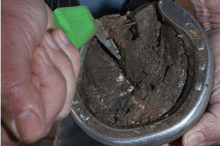Horse hooves - What to do and when to do It
Get to know your horse's hooves. Make sure that the horse's hooves are picked and cleaned on a regular basis, usually before and after each ride, or at least a couple of times a week.

Picking a horse's feet
A hoof pick and a good pair of eyes are the most important tools for keeping your horse's feet healthy.
©Amy McBirney
While picking out any small rocks or objects, pay attention to what is going on with each hoof. Is the temperature and pulse normal? Does the frog have a firm texture, without any indication of problems?
Note any signs of injury, including punctures. Sniff the horse's feet to make sure that no bad odors are present, indicating thrush or other infections.
Make sure your horse's diet provides the best possible hoof health. Check with your veterinarian or farrier to see if the diet is adequate or if a change in feed or the addition of supplements would be helpful.
If your horse is shod, check the shoes on a regular basis, even if the horse is more of a pasture ornament and isn't ridden often. Make sure all nails are in the correct position and that the shoe isn't loose, pulling away, or shifting position. Call the farrier whenever you see problems with the shoes.
If you are hauling the horse to shows, events, or for trail rides, protect the horse's hooves by using proper bandages or boots. Several good options are available, including bandages and boots with velcro fasteners for easy application and removal.
Don't allow your horse to spend time standing in mud, wet grass, boggy pasture, or unsanitary, urine-soaked bedding. These conditions lead to swelling and softening of the hooves, which may allow the nails of the horseshoes to loosen.
When wet conditions are followed by dry conditions, the hooves will split or crack, leading to discomfort and providing a pathway for infections that may lead to abscesses. In addition, a horse that is left standing in mud or boggy pasture may develop thrush or scratches that can lead to lameness.
Work with your farrier by scheduling regular visits. Once a farrier gets to know the horse's needs, a timetable of visits can be worked out to make sure hoof health is an ongoing priority.
In many cases, a capable farrier will be willing to instruct the horse's owner in day-to-day care of the hooves and shoes to maximize care without straining the budget or time schedules of those involved.
Dig deeperTM
Let the learning begin. If you enjoyed this article, we hope you will also read and enjoy Hoof Growth - What Helps and What Hurts.
